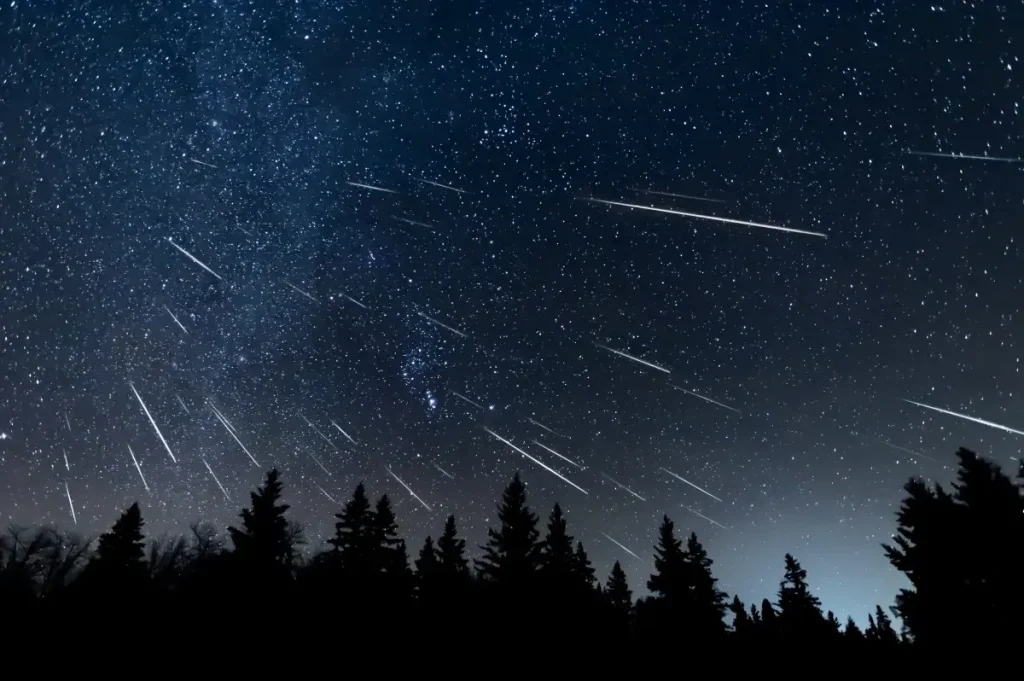The Orionids: A Celestial Light Show from Halley’s Comet
As October unfolds, stargazers worldwide are in for a treat as the Orionid meteor shower prepares to illuminate night skies across the globe. This annual celestial event, named after the constellation Orion from which the meteors appear to originate, offers a spectacular display as Earth passes through debris left behind by the famous Halley’s Comet. Though the comet itself is currently far from view and won’t return until July 2061 (having last visited in 1986), its cosmic trail creates a magnificent light show each October. First discovered by English astronomer Edmund Halley, who calculated its 76-year orbit, this comet’s remnants now create one of the year’s most anticipated astronomical events.
What makes the Orionids particularly fascinating is their remarkable speed—these meteors hurtle into Earth’s atmosphere at an astonishing 147,600 miles per hour. Such velocity creates beautiful “trains” or ionized gas trails that linger for several seconds after each meteor passes, adding to the visual drama of the event. While not producing the most abundant displays compared to other annual meteor showers, the Orionids compensate with their distinctive appearance and the historical significance of their origin. The shower’s connection to Halley’s Comet—perhaps the most famous comet in human history—gives it special appeal among astronomers and casual stargazers alike.
This year’s Orionid shower spans from October 2 to November 7, with its peak activity occurring in the early morning hours of October 22. However, Seth McGowan, president at Adirondack Sky Center and Observatory in New York and a NASA Solar System Ambassador, reassures observers that the show isn’t limited to a single night. Meteors should be visible for several days before and after the peak, giving everyone ample opportunity to witness this cosmic spectacle. Fortuitously, this year’s peak coincides with a new moon, meaning darker skies that create ideal conditions for spotting the 10 to 20 meteors per hour typically visible during maximum activity.
Finding the Orionids requires no special equipment—these meteors are readily visible to the naked eye, though viewers will need to allow their eyes to adjust to darkness. McGowan explains that locating them is relatively straightforward since most people can easily identify Orion’s Belt with its three bright, aligned stars. “The Orion Constellation will rise from the eastern horizon at roughly 10:00 PM, depending on your location in the US,” McGowan notes, “appearing approximately 45 degrees above the southern horizon by around 4:00 AM.” However, he emphasizes that meteors will streak across the entire sky, not just near Orion. The identifying characteristic is that regardless of where they appear, the meteors’ paths will generally trace back toward the Orion constellation.
For optimal viewing, seekers of this celestial show should find dark, wide-open spaces away from light pollution. Urban dwellers may need to venture outside city limits to escape the glow of streetlights that can wash out the meteors’ trails. Higher elevations are particularly advantageous, offering broader, unobstructed views of the horizon and reducing atmospheric interference. The beauty of meteor watching lies in its accessibility—unlike many astronomical observations that require telescopes or specialized knowledge, the Orionids can be enjoyed with nothing more than a comfortable chair, warm clothing, and a clear view of the night sky.
McGowan offers practical advice for those planning their meteor-watching excursion: “Regardless of where you choose, please monitor weather conditions. Cloudy skies can make a trip disappointing, and cold temperatures can make it very uncomfortable.” October nights can be chilly in many regions, so bringing blankets, warm beverages, and dressing in layers will enhance the experience. Patience is also essential—the human eye typically needs 20-30 minutes to fully adapt to darkness, and meteors often appear in clusters with quiet periods between. Those who prepare properly and approach the event with patience will be rewarded with one of nature’s most dazzling displays—fiery streaks of cosmic debris from a comet first documented centuries ago, still captivating human imagination as they illuminate our night skies.















